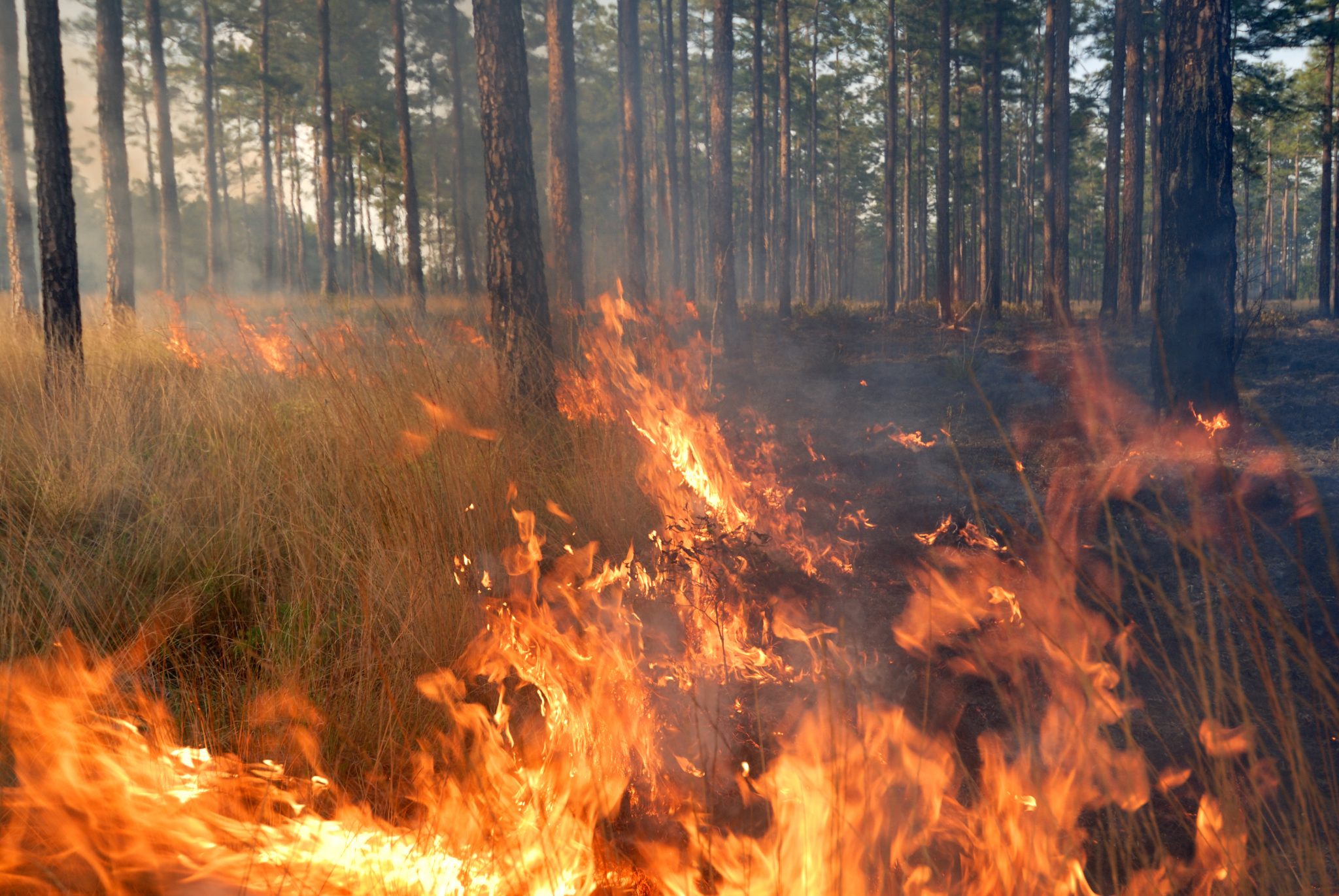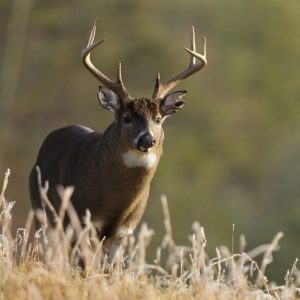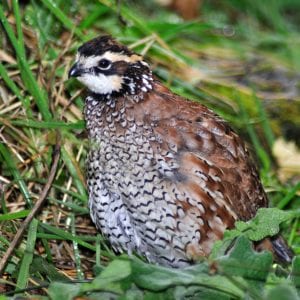Fire

This is the fourth in a four-part series on the use of prescribed fire in forested settings. Learn how prescribed fire benefits selected wildlife species and the conditions associated with conducting a burn to produce those results. Prescribed fire can be used effectively in a variety of habitat types including fields, grasslands, and prairies. This document focuses primarily on its benefits in woodlands.
Basic Habitat Requirements of Wildlife
All wildlife requires food, water, shelter, and space to survive. Successful wildlife management includes manipulating the habitat to increase or decrease the carrying capacity or how many animals an area will support. All wildlife need water that may be obtained through diet or in a free-standing form. Except in rare instances, water is not the limiting factor for a wildlife species in the southeastern United States. Wildlife need shelter for reproductive success, escape from predators, and protection from the elements. To provide the needed shelter, a good management plan must include burns of differing frequencies
(years between burns) and across different seasons (dormant and growing seasons) to produce a mosaic of habitat conditions.
Food is species dependent and time of the year dependent. What a species may need during one time of year may be different from what it needs at another time of year. You need a good understanding of the food needs of the wildlife species you might manage.
Space is necessary for wildlife to have access to food, water, and shelter. If not enough space is available, then overcompetition can result, leading to stress and diseases. It is important to know the amount of territorial space a species needs for mating and nesting.
Nature does not stand still and, if something is not done to interrupt the process, an area will progress from bare ground to a mature forest—a process called succession. How quickly this process of ecological succession will happen depends on the specific physical and climatic conditions of the area. Interspersion is the management of different successional stages within a landscape. In general, more interspersion supports a greater diversity of wildlife but does not necessarily benefit all species. Prescribed fire is a useful tool to help set back succession.
In addition to setting back succession, prescribed fire can be used to maintain a habitat that is suitable for the desired wildlife species. Some wildlife species prefer a grassy, open understory achieved by annual burning to eliminate young, woody vegetation and promote the growth of various grasses and legumes, which are high in protein. Where some woody vegetation and thicker cover are desired for wildlife species, a burning regime should include fire on a 3- to 5-year interval.
In a woodland area, a growing season fire tends to be better at controlling woody vegetation (figures 1 and 2) because the warmer weather aids in heating the cambium layer of the vegetation. Conversely, if you are trying to preserve the woody understory, using a dormant-season fire tends to produce a fire of lower intensity that may not set back all woody vegetation.
- Figure 1. Effects of prescribed fire used every 2 years in the growing season on understory vegetation on a longleaf pine forest near Brewton, Alabama. Notice the grasses and patchy low vegetation in the understory that allow for food and cover for birds such as turkey and quail and for small mammals such as squirrels.
- Figure 2. Effects of prescribed fire used every 2 years in the dormant season on understory vegetation on a longleaf pine forest near Brewton, Alabama. Notice that there are fewer grasses and more woody vegetation in the understory. Over time, hardwoods such as sweetgum will progress into the midstory.
Effects of Fire on Habitat for Selected Wildlife Species
The following discussion covers some but not every species that benefits from the use of prescribed fire. Focus is on species that include wooded areas in their preferred habitat and how fire may be used to maintain or improve those areas.
People enjoy a love-hate relationship with white-tailed deer (figure 3). This species is the most popular game animal in North America but is also responsible for millions of dollars in damage to agriculture and property. The enhancement of white-tailed deer habitat involves creating a variety of habitat stages from open fields to mature forests. Interspersion is key to good white-tailed deer habitat, and prescribed fire may be used to facilitate that mix. It is often said that deer do not eat the tops of pine trees and, within the forest, prescribed fire will aid in the growth of forage and mast. Along the forest edge and adjacent to fields, fire may be used to promote and preserve shrubs that provide cover and browse.
Wild turkeys (figure 4) use a variety of habitat types including woodlands in various stages of ecological succession ranging from brushy field edges to mature forests for roosting and foraging as well as opening of early successional herbaceous vegetation for nesting, brood rearing, and foraging. Acorns are an important part of their diet as are insects (high in protein) that are eaten primarily by poults and hens as they began to nest. Prescribed fire may be used to produce and maintain an understory that contains nesting cover, escape cover, foraging, and roosting habitat. Depending on the specific situation, a combination of growing- and dormant-season fires may be required.
Bobwhite (figure 5) habitat includes open grassy areas, shrubby cover, and forested areas of intensively managed pines that are maintained at an open spacing (a basal area of 50 square feet/acre if the trees are larger) and an open understory. The bobwhite is adapted to fire, and its habitat is maintained using frequent (even annual) growing- season fires. This management strategy is needed to encourage establishment of native bunch grasses and forbs. Bare ground is important to allow quail to move between herbaceous cover as they forage. Small areas of shrubby, unburned spots within a stand or edges of riparian areas provide important escape cover for quail. Effective management for quail includes establishing a mosaic of management blocks with different fire regimes.
- Figure 3. White-tailed deer.
- Figure 4. Wild turkey.
- Figure 5. Bobwhite.
Gray squirrels (figure 6) and fox squirrels are both native to southern forests. While gray squirrels may be a nuisance to homeowners, they are a popular game species of many hunters. In forestlands, gray squirrels and fox squirrels are typically not considered a nuisance and are an essential component of hardwood regeneration through their instinctive caching of seeds. Dormant-season fires can be used to maintain hardwoods and pines with a relatively open understory for foraging. Fires of a higher intensity, often in the growing season, may be required to control hardwood encroachment in open areas.
Barred owls (figure 7) are large birds found in rural and urban areas. They may go unnoticed until one hears the familiar Who cooks for you? hoot in the early evening. Prescribed fire may be used to promote herbaceous ground cover, reduce woody competition, and increase the carrying capacity for small rodents and other prey species. These fires should be low intensity with fire lines placed around large snag trees. These dead trees may contain cavities in which barred owls may nest. Snags are an important feature to protect in woodlands because they not only serve as a home for birds, mammals, and reptiles but are also home to a tremendous number of macroinvertebrates on which many species survive.
Red-cockaded woodpeckers (figure 8), often referred to as RCWs by biologists and foresters, are a species of the Southeast typically associated with longleaf (and sometimes shortleaf) pine ecosystems. Because of a drastic decline in habitat, they were classified as endangered in the 1970s and were one of the first bird species listed. Prescribed fire is essential for successful RCW management to control hardwoods and midstory. The RCW needs mature trees because young trees may not be large enough in diameter for cavity excavation. Unlike other species of woodpeckers, RCWs will choose live trees to cavity and nest in because of the protective barrier formed by resin. Through the use of growing- season fire, the forest midstory can be controlled to aid in reducing the risk of predation and other nest competitors. Much of an RCW’s diet is insects foraged from under loose pine bark. Through habitat restoration and sound wildlife management, the RCW has begun to make a comeback in some areas.
- Figure 6. Gray squirrel.
- Figure 7. Barred owl.
- Figure 8. Red-cockaded woodpecker.
Conclusion
Prescribed fire improves browse and forage quality for wildlife by creating a more open midstory and understory. Prescribed fire improves forage quality by increasing the availability of grasses and forbs, nutrient content, palatability, and digestibility. However, the success and sustainability of these results depend on the frequency, season, and intensity of the prescribed fire. Further, the results of a prescribed fire highly depend on site, weather conditions, and landowner objectives. It is important to consider these factors as they relate to the wildlife species you want to manage. Fire creates change in ecosystems and many natural communities require fire to be sustainable. Fire influences the diversity, composition, and distribution of grasses, forbs, plants, and tree components within an ecosystem along with the associated wildlife species. Using prescribed fire as a management tool is the most cost effective means of creating change and maintaining habitat for the benefit of wildlife.
Download a PDF of Prescribed Fire: Wildlife, FOR-2086.










